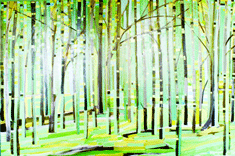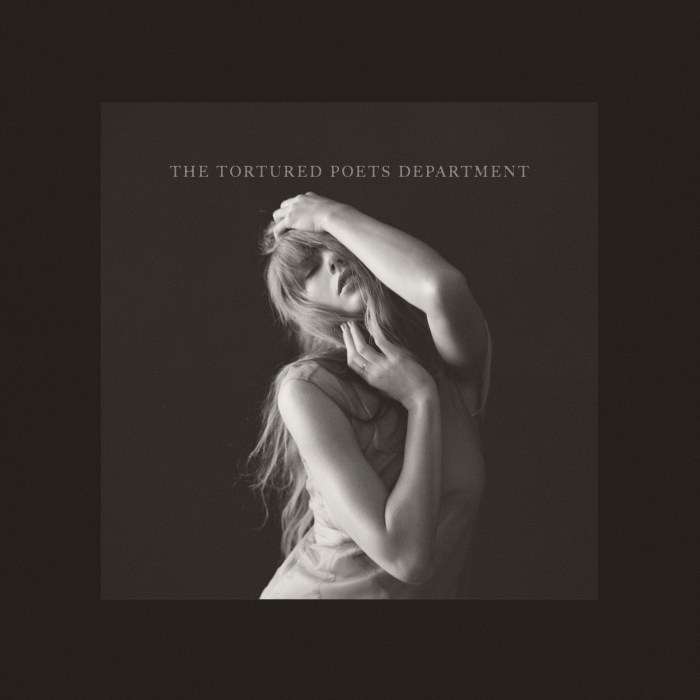P.S. 1 show explores noble savagery, ravaged nature and totalitarian collectivity
Wandering through the “Greater New York 2005” show at P.S. 1 brought to mind Rousseau—both Jean-Jacques and Henri. In my mind, the 18th-century philosopher of noble savagery leads to the early 20th-century painter of proto-surrealist tropics.
“The first man who, having fenced off a plot of land, thought of saying, ‘This is mine’… was the real founder of civil society,” Jean-Jacques wrote in 1755, having imagined a harmonious, nature-friendly pre-civilization. “How many crimes, wars, murders… might the human race had been spared by the one who… had shouted to his fellow men: ‘Beware of listening to this imposter; you are lost if you forget the fruits of the earth belong to all and the earth belongs to no one.’”
By 1889, a century after Jean-Jacques’ call for government by common will inspired the French Revolution, Henri could sketch the imported exotica at Paris’ Jardin des Plantes and declare, “When I go out in the country and see all that sun, all that greenery and all those flowers, I sometimes say to myself, ‘All that belongs to me, it does.’”
Jean-Jacques Rousseau’s “let us return to nature” had become “let nature come to us.” The royal acquisitiveness of Versailles had diffused into the democratic inquisitiveness of the Exposition Universelle of 1900. Everyone could taunt the chained elephants now. The exercise of the common will made us no better citizens of the planet. Theorists have pointed out that Jean-Jacques’ government by universal consensus supports the development of socialism as well as totalitarianism—the collective becomes absolute ruler.
At P.S. 1, noble savagery, ravaged nature and totalitarian collectivity ring out from works by more than 160 New York artists on display through June 25. Much ink has been spilled over the curatorial process, but if the museum is intended for us commoners, then art-world politics are less interesting than what the show says about the concerns of New York artists and, by extension, the rest of us. By the looks of it, we’re anxious about what we’ve done to the world. It’s an open question as to whether we’re willing to right our wrongs.
There’s a lot of violation and mourning at P.S. 1. One of the first pieces viewers encounter is Bethany Bristow’s “Insinuate.” In bright feathers and broken bottle, spilling from corners and dripping from windowsills, it looks like carnage from a natural history museum. I thought of Charles Wilson Peale, founder of America’s first museum, quarantining his family during a yellow fever epidemic and surviving on bird specimens. I thought of Marjan, the grenade-disfigured lion in the Kabul Zoo, opening his one good eye to see that many of his inmates had been eaten.
The mistreated animal spirit stalks particular rooms. In Aaron Young’s video, “Good Boy,” a pit bull dangles, whimpering, lockjawed from a chain. A male voice eggs him on, “Good boy!” That voice and the clinking of the dog’s chain enhance the experience of nearby works that echo our abuse of the planet’s other inhabitants.
Gina Magid’s painting, “Green Palm Trees,” is deceptively pretty—a delicately drawn wolf’s head, palm trees and orchids float on a background of deep green satin. But the wolf is rendered in graphite. He’s erasable, threatened with extinction or (“Good boy!”) a sad domestication. The trees are skeletal, like the imported royal palms planted in artificial rows on the Beverly Hills graves of native species. The satin is two pieces stitched together. The joining is also a fissure; the landscape is torn.
Hope Atherton’s title “Unicorn,” too, suggests extinction. Tiny and brown in ratty lambskin, it droops from a rope on the gallery wall. It is profoundly diminished from the glittering creature of myth. Next to it, in Atherton’s acrylic-on-linen “The Watcher,” a dispirited monkey sits by a chiaroscuro tenement window, peering pie-eyed at us. Read literally, it is not far from the captive inspirations for Henri Rousseau’s “Tropical Forest with Monkeys” but it is far from their idyllic portrayal. The black-market trade in exotic animals is a multi-billion dollar business. What a miserable circumstance we’ve wrought.
The tension runs to foliage too. A backdrop that looks like skyscrapers and a freeway’s cloverleaf frame the trees in Benjamin Butler’s painting, “In the Forest.” Kristin Baker’s “Portrait of a Whatever Agricultural Experience” depicts what looks like the speed-blurred wreck of an agro-industrial vehicle in front of a factory-farm crop tall and solid enough to be a prison wall.
Upstairs, Yuken Teruya has carved extraordinary, artificial bonsais out of the sides of brand-name paper shopping bags and has displayed them still attached to and tucked inside the bags. The destroyed, digested, discarded tree has been ressurected from its gutted body. Nature is commodified, branded. The final, inadvertent joke is the query on the McDonald’s bag, “How are we doing?” Next to Teruya’s piece, Michelle Segre’s eight-foot beeswax and papier mâché “Mushroom” stands on its head like an enormous defeat, as if in answer.
If the show leaves one thinking about how badly we treat the earth, what about how we treat each other? For Jean-Jacques Rousseau, nature signified spiritual and creative freedom. It came to mean, in essence, art. Ravaged nature in the P.S. 1 show can be taken as metaphor for the oppressions of the art world. Several artists bite back, noble savages devouring the museum’s physical structure. Daniel Arsham has carved an erosion that looks like an ice cave out of a corner wall. Valerie Hegarty seems to have shredded the insulation around a heating pipe to create “Birch Tree.” Corey McCorkle’s “Heiligenshein” is a large circle cut from an outer wall and suspended almost in place, sunlight seeping around it like a full eclipse.
And then there’s the war. How can you create beauty and metaphor from real, contemporary suffering? It is a fraught endeavor. The best pieces are reportorial. Done on the fly in life-threatening circumstances and accompanied by journal entries like “I ducked below and passed up ammunition….,” Steve Mumford’s watercolor-and-ink “Drawings from Baghdad Journal” are stiff as a courthouse artist’s but also simple, elegant and real. Their strict reportage is, perhaps, the only justice Mumford could do to devastated Iraq. They almost cannot be judged as art.
The war lends a dark read to some installations. In the September 2004 ArtForum, critic Arthur Danto remarked ironically that torture photos from Abu Ghraib prison “might well be among the exhibits of the 2006 [Whitney] Biennial” because “hideous as the conduct they depict is, the Abu Ghraib photographs are powerful examples of how images can change what we are, and from that perspective they must from now on act as standards against which we can judge the political efficacy of art.”
There are no torture images from Abu Ghraib at P.S. 1. But Paolo Canevari’s special courtyard project “Welcome to Oz”—a faux barbed-wire enclosure rendered in rubber, its title taken from a sign outside Abu Ghraib—signals that the scandal looms in the American conscience. The incarcerated creatures of the “Greater New York” installations are proxies for Iraqis in Abu Ghraib and other dissidents at Guantanamo.
For “The Pit,” Will Ryman has built a dry-wall container with stairs leading up to a viewing platform above it. Boxed inside are scores of little brown papier-mâché humanoid figures looking up at the viewer, with flipper-like arms and mouths agape in little o’s. There is no way out. They are naked but for their sneakered and sandaled feet. I thought of the piles of shoes left over from the Nazi death camps. I thought of the phrase “we did nothing.”
In “Overseer,” Peter Caine has filled a room with stationary, mechanized abominable snowmen, in white fur with black faces, mugging fiercely but looking bewildered. Bellows and growls play over the machinery’s squeaks. The installation would be coy if it weren’t disturbing. The work’s title and the whiteness surrounding black, half-animal/half-human faces connote a racist objectification. The viewer is the “Overseer.” We move on, but we remain implicated.
Ryman’s and Caine’s subjects are Jean-Jacques Rousseau’s noble savages. It’s problematic to take less-than-human sculptural forms for proxies of actual abused humans, particularly when those humans have been so utterly marginalized in the media and by our government. And, yet, the tropes of war, imperialism, imprisonment, torture and our collective responsibility have entered our consciousness and come out in our art.
The viewer is implicated not so much in viewing Wangechi Mutu’s installation as through the nose. You smell it before you see it. It’s as yeasty as baking bread. The aroma comes from an open bottle of red wine, suspended upside-down and clamped to drip, like blood, slowly onto the floor. On the walls, amid a swarm of moths with showgirl legs, are blood-red wounds or a machine gun’s pockmarks. When you read the installation’s title—“Once upon a time there lived a people who liked to kill, but even more they relished watching one another die”—you are ashamed of your appetite for that odor.
Mike Bouchet uses odor to nauseating effect in his cardboard-box “Celebrity Jacuzzi” series. The stench comes from a giant sausage afloat in the “Kofi Annan” Jacuzzi. The stink of rotting flesh recalls a telegram sent from Rwanda that read, “We wish to inform you that tomorrow we will be killed with our families” and a U.N. secretary general who did nothing.
As the world, with our nation at its vanguard, marches on to more war, more destruction of nature, more genocide, and artists soak it all in and represent, art begs the implicit question, what shall we do to reverse the horrible momentum? It is the viewers’ responsibility to answer that question. Let us hope, at least, we do something—one shudders to anticipate what that gallery housing the Jacuzzi will smell like by the time the “Greater New York” show closes in June.
gaycitynews.com




































